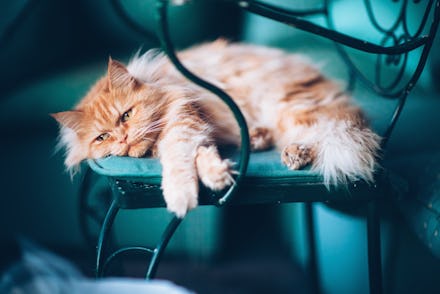How to tell if your cat is depressed

Cats are emotionally complex. And I don’t just mean that in the general “science can’t be certain what animals are thinking” way. I mean that they toy with our emotions. We can kind of sense when they’re happy — there's that low, motorcycle purr when you scratch the right spot under their ears — but also have no clue why they just just withdraw sometimes, pointedly walking away from us, tail in the air, almost as if to say: I’m done with you, peasant. I’m going to go brood about the deplorable condition of the world. That’s all fine and good, but how can we tell if a cat is depressed? I asked a veterinarian to explain how to determine if your pet is dealing with more than resting cat face.
Pet parents diagnosing their feline friends with depression is believed to more likely be us projecting human feeling states onto our fur babies than it is to be actual depression.
J. J. Rawlinson, a veterinarian at Wallis Annenberg PetSpace, a pet community center in California, schooled me about the idea of cat depression. “Depression, as we think about in people, does not really occur [in cats],” she says. “Cats that are acting depressed often have a medical condition.” They may be, for example, nauseous or experiencing arthritis. In other words, many veterinarians don’t believe that cats suffer from emotional tumult the same way humans do. Pet parents diagnosing their feline friends with depression is believed to more likely be us projecting human feeling states onto our fur babies than it is to be actual depression.
The good news, here, is that sad cats are probably not sad. The bad news is that cats who seem sad may actually be physically sick. That means that it’s extra important to stay tuned-in to signs that you might be tempted to attribute to depression because cat moods are subtle health barometers.
What to look out for
“Cats are very adept at hiding their pain or any signs of illness,” Rawlinson tells Mic. “So if a cat is withdrawn or acting quieter than usual, it can be a sign something medically significant is going on.”
But what if your cat is always quiet? “Any change in a cat’s normal behavior can be a concern,” she explains. That means that you’re going to want to get in touch with all the nuances of your cat’s behavior in order to keep good tabs on their health.
But changes in behavior don’t necessarily indicate a serious problem, says Rawlinson. It could just be that they don’t like some aspect of the living situation. “If a cat is unhappy with something in their environment, they often show it through their behavior,” she explains. “They can urinate outside the litter box or act aggressively towards people. They may have a change in their sleep habits or may groom less or more than normal. They may spend less time interacting with their owners or other pets in the house.”
A sidenote: No one likes to think about the litter box, but your cat's relationship with it is a primary indicator of how they're feeling about life. Peeing outside the box is a sure sign of discontent, says Rawlinson.
What to do if your cat seems depressed
If your cat is showing negative changes in behavior, get them to a vet. “A complete health assessment is the first priority,” says Rawlinson. If a vet determines that your cat is healthy and she still isn’t acting like herself, it’s time, says Rawlinson, to evaluate the ct’s environment.
The environment you create for your cat kid is particularly important if they stay inside. “Cats are skilled hunters,” says Rawlinson. “Being indoor and sedentary can create undue stress and cause them to act depressed or withdrawn.” They may even act out in ways that we see as aggressive or uncouth, like being more vocal or not using the litter box.
What to do to make an inside cat happier
“Indoor cats need to be able to exhibit their natural behaviors to be ‘happy,’ says Rawlinson. That might mean investing in some fancy pet furniture, just rearranging, or even going for a walk outside if your cat is willing and able. “Climbing up high, hunting, and having places to scratch and feel safe are all needs that indoor cats have,” Rawlinson says.
Notice how she said “need”: Cats need different environments than humans tend to prefer, but we insist that they acclimate to our preferences. If we want happy cats, we’re going to have to compromise. Rawlinson suggests that cat parents get educated about their cats needs to make sure that they stay healthy and (at least seem) happy.